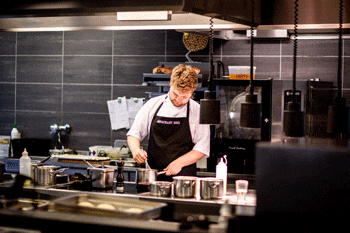
Ghost kitchens are virtual restaurants created on app platforms. No cooking or restaurant experience is necessary to create one. This is the easiest way to have your own restaurant.
According to Cloudkitchens.com, if you have a concept in mind, a menu, and the right amount of cash, you can have a restaurant. Ghost kitchens use existing restaurants to cook the menu items and package them for take-out. This concept of virtual kitchens arose before the pandemic came upon us; however, with the surge of take-out and delivery during the pandemic, virtual kitchens became more popular. In today’s restaurant world, deliveries make up 60% of total sales; hence, virtual kitchens have found fertile ground for their sales.
How do ghost kitchens operate? They do so through ordering apps, such as DoorDash or UberEats. Customers who want to order their meal delivered, choose a restaurant on a delivery platform, browse the menu, and pay online.
Meanwhile, the restaurant receives the order on a dedicated ordering system, prepares the food, packages it for delivery, and hands it out to a delivery driver.
This new business model was welcomed by brick-and-mortar restaurants that lost business during the initial stages of the pandemic.
With dining rooms empty, and increased demand for delivery, many restaurants agreed to be the kitchen where virtual menus are prepared. It sounds like the perfect solution to a serious problem. Ghost kitchens have kept many restaurants in business and people in the workforce.
Who is the target customer for ghost kitchens? According to statistics, Gen Z (18 to 24 years old) is the section of the population who orders the most, followed by Millennials (25 to 40 years old). The target market of virtual kitchens is key to understanding why they have become so popular.
There are pros and cons to this new business model. The advantages are many, especially for restaurants. Virtual kitchens do not require much capital to start up a restaurant. There are no remodel or building expenses. Overhead is practically nonexistent, and the hiring and firing headache is not even an afterthought.
The restaurants who agree to be the brick and mortar for the virtual kitchen keep busy with online orders and do not have to worry about hiring delivery drivers, as they come with the package deal. What are the disadvantages? Lack of transparency, for starters. But, that might not be a priority for Gen Z and Millennials. I assume the rest of us would like to know where the food is prepared, or that the food comes from a virtual kitchen.
Some folks care about the sanitation score of restaurants. With virtual kitchens, such a score is unknown because the menu found online doesn’t disclose where the food is prepared.
It’s obvious, due to the current circumstances, that ghost kitchens are here to stay, as long as people request delivery or carry out.
Perhaps, with customer demand, there will be more transparency.